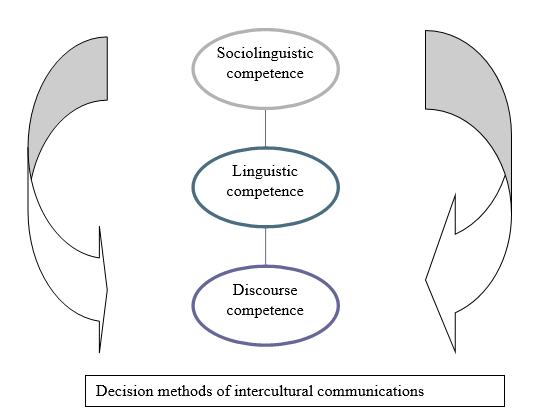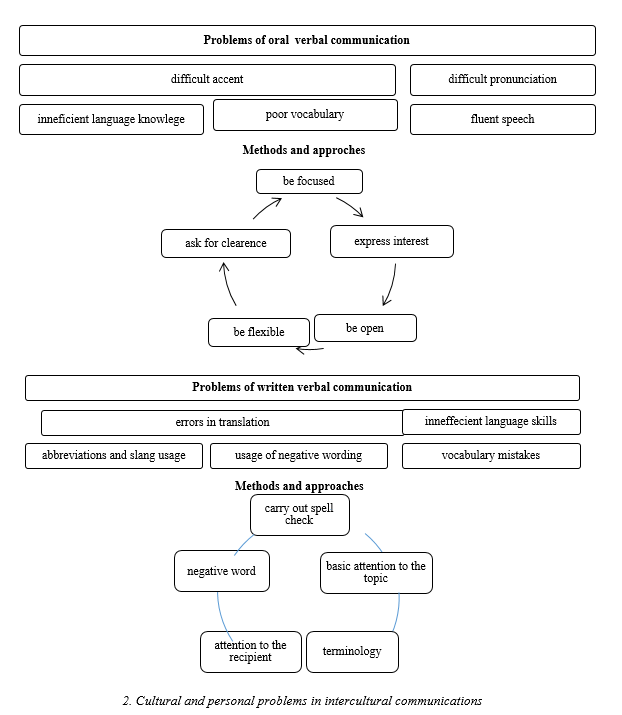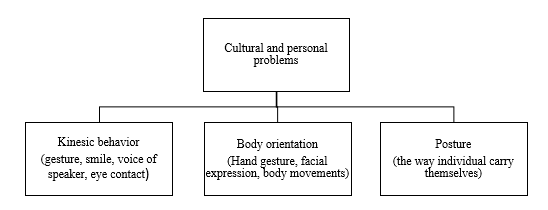Abstract
The key issue of the paper is the research of fundamental principles and issues of intercultural communication. It proposes to develop some academic perception of an appreciation for different cultural perspectives and values. The research object of the investigation is the national mentality as an example of its expressions in intercultural communication. The article defines theoretical approaches to the study of intercultural communication concept. Based on the analysis of scientific literature and conducted expert survey, the author analyzes the problems arising in intercultural communications. Three basic categories in intercultural environment are identified, namely: language problems, cultural problems, and personal perception problems. Analysis of scientific research and expert opinion indicates that the application of soft skills is the main tool that is used to solve problems and challenges associated with the human factor in intercultural communication in a multicultural environment. Therefore, when communication is carried out in a multicultural environment, it is necessary to formalize special requirements to intercultural competences of communicators.
Keywords: Intercultural communicationhuman factormulticultural environmentbenefitsociolinguistic competencediscourse competence
Introduction
Intercultural communication in today’s global world is a broad topic. With the globalisation of business, there has been an increasing interest in intercultural communication. Unfortunately, much of the interest is not in the scientific body of knowledge related to intercultural communications but instead is focused on learning cultural tips and etiquette for particular countries. While there is value in understanding the customs of specific cultures, it is more efficient and effective to establish a baseline understanding of intercultural communication, which may then be applied in a variety of cultures.
However, the impact of intercultural communication on global business has seldom, if ever, been successfully measured. Unsuccessful joint ventures, marketing gaffes due to inaccurate translations and failed forays into new markets are rarely attributed solely to ineffective cultural understanding and communications. It is unrealistic to expect that a single aspect of a global business environment could be isolated and measured to any degree of accuracy. For this to happen, research and business case history would need to intersect in a systematic manner, using a pre-determined scorecard.
Current world events lead us to believe that our collective ability to communicate interculturally is insufficient. Sadly, with warfare still a modern reality, we cannot underestimate the importance of understanding and communicating with cultures different from our own. The greater the (psychological) distance between two cultures, the more difficultly there will be in intercultural understanding.
Problem Statement
Studying intercultural communication in the linguistic aspect, Russian scientists have identified several development areas, such as linguistics, cultural studies, ethnolinguistics, etc. Each of these directions is based on the interaction of language and culture and hence is of the interest for intercultural communication. For example, linguistics and regional studies are important in the interaction of culture and language. Ethnolinguistics is focused on the study of the interaction of language with various aspects of the life of peoples, as well as the role of language in the culture of the people. Linguoculturology, in turn, explores the rituals, ceremonies, symbols, and stereotypes enshrined in the language, exploring their interaction.
The hypothesis of the present research is formulated as follows: the increase of the intercultural communication effectiveness in a multicultural environment can be achieved through the use of appropriate methods and approaches to solving communication problems of linguistic, cultural, and personal nature.
Research Questions
In writing this paper, the author relies on the scientific research and applied development of Russian and foreign scientists and practitioners on the research problems in cross-cultural communication, particular, in the functioning of person’s mentality and cultural environment. The paper uses a dialectical method of cognition and a systematic approach to the study of the problem; applied general scientific and special research methods: analysis, in particular comparative analysis, synthesis, analogy, classification, as well as historical and logical methods, tabular and graphical techniques. The information base of the work is foreign legal research in the field of business communication. When writing the article, the official statistical information is used, as well as information from the official websites of research agencies, institutes and other organizations;
Purpose of the Study
This research paper applies to the possibility of learning the meanings of cultural interaction on the basis of transactions between different cultural worlds, symbolic systems, individual and collective cultures. Perhaps the process of renewal of qualitative research methods in the context of cross-cultural and intercultural communication really needs to start with a reflection over the life history of the researcher given that the researcher is also immersed in the norms, values and beliefs of the institutions, communities and movements in which she or he functions, and which give ideological form to the whole process.
Research Methods
a. General description
The theoretical study was based on the methods of system analysis, as well as the theories of international management and intercultural communications.
The authors have carried out a study of the existing literature focused on the problems that arise in international communication in projects and considered approaches to their solution. To analyze the existing problems, the literature was reviewed using keywords such as communication, international, intercultural, intercultural skills, and intercultural competence, because these aspects reflect the human factor in the problems related to communication. The following databases were used: Science Direct, Google Scholar, and Web of Science. The task of this research was to review and analyze the problems, methods, and approaches to their solution used to manage international and intercultural communications.
The literature review allowed developing an approach to classifying the problems inherent in international communications in a multicultural environment. In turn, the developed classification of problems allowed ordering the approaches and methods defined in the literature and research to solve problems in intercultural communications. The problems, corresponding methods, and approaches to their solution developed by the authors include also generally accepted types of communications.
Besides, the expert survey was also used to determine the methods and approaches to solving the problems of intercultural communication.
The online survey involved 29 experts, including managers of international projects (17 persons), as well as university staff, namely, teachers of the Department of Management (12 persons).
The experts were asked a number of questions concerning the intercultural communication problems, as well as methods and approaches to their solution.
b. Algorithm
At the first stage of the research, the analysis of scientific literature on the problem of the human factor in intercultural communications was carried out.
At the second stage of the study, an expert survey was conducted on the problems directly related to international communication in a multicultural environment, as well as methods and approaches to their solution.
The stages are presented in Figure

Findings
6.1. Research results
Let us consider successively the problem categories that are directly related to international communication in a multicultural environment.
1. Language problems in intercultural communication
Language problems are recognized by the experts participating in the survey as the most common type of problems occurring in international communication and multicultural environment. Problems arising from the use of a non-native language as a common means of communication are usually divided by the type of communication: verbal, nonverbal, and paraverbal.
Language is a part of culture because language is the vehicle for nearly every type of cultural expression. Even seemingly, wordless artifacts in media such as music, dance, food, costume and handicrafts are ultimately transmitted from one generation to the next via lessons, apprenticeships, recipes, and instructions that are expressed using language. Cultural concepts are embedded in language, and the architecture of each language contains culturally specific features. These include both lexical and grammatical characteristics. The lexical characteristics are often the most obvious and tend to attract more attention. Some social scientists consider that without language, culture would not be possible. Language simultaneously reflects culture and is influenced and shaped by it. In the broadest sense, it is also the symbolic representation of a people, since it comprises their historical and cultural backgrounds, as well as their approach to life and their ways of living and thinking. In a word, culture and language are inseparable. Many linguists exploring the relationship between language and culture hold the view that language and culture are two symbolic systems. Everything we say in language has meanings, designative or sociative, denotative or connotative. Every language form we use has meanings, carries meanings that are not in the same sense because it is associated with culture and culture is more extensive than language.

Cultural differences often become factors of misunderstanding and inaccuracies in intercultural communications. According to the experts, the main problem is the communication transmission process, where, initially, the notification is compiled and “encoded” in one cultural context, while after transmission, upon receipt, it is "decoded" in another cultural context.
Studies in this regard note that cultural influence on the individual is a significant factor influencing beliefs and behavior models, namely, trust and fear, lack of participation, and willingness to fulfill obligations, lack of openness, and dissemination of information (Luckmann & Farber, 2016)
According to experts, understanding and using cultural differences gives communicants the opportunity to create an environment of mutual trust and mutually beneficial cooperation. Thus, intercultural and personal aspects of communication are interrelated. Let us analyze the problems and challenges related to the personal perception of the individual. The problems of cultural and personal issues and the corresponding methods and approaches to their solution are given in Figure
Types of cultural and personal problems are presented in Figure

6.2. Discussion
While discussing the language-related problems in intercultural communications, experts note that the key to effective cross-cultural communication is knowledge. Firstly, it is essential that people need to understand the potential problems of cross-cultural communication, and make an effort to overcome these problems. Secondly, it is important to assume that one’s efforts will not always be successful, and adjust one’s behavior appropriately. For example, one should always assume that there is a significant possibility that cultural difficulties are causing communication problems, and willing to be patient and forgiving rather than hostile and aggressive, if problems continue to develop.
One should respond slowly and carefully in cross-cultural exchanges, not jumping to the conclusion that you know what is being taught and said. Often intermediaries who are familiar with both cultures can be helpful in cross-cultural communication situations. They can translate both the substance and the manner of what is said. For instance, they can tone down strong statements that would be considered appropriate in one culture but not in another, before they are given to people from a culture that does not talk in such a strong way. They can also adjust the timing of what is said and done. Some cultures move quickly to the point, others talk about things long enough to establish rapport or a relationship with the other person. Effective communication with people of different cultures is especially challenging. Cultures provide people with ways of thinking – ways of seeing, hearing and interpreting the world. Thus, the same words can mean different things to people from different cultures, even when they talk the “same” language. When the languages are different and translation has to be used to communicate, the potential for misunderstanding increases. It is perceived as the best way of communication (Javidan & House, 2001). The experts underline that despite this fact, verbal communication should be supported by written communication where possible, especially in the case of the transmission of important information.
Another fact, which according to experts, should be kept in mind to minimize language misunderstandings and inaccuracies in intercultural communication, is the inability to guarantee one hundred percent appropriate level of language proficiency. At the beginning of the business intercultural communication process, the language skills of communicants may not be identified accurately. Since language and culture are interrelated, the mental aptitudes of some nationalities, especially in the case of proficiency in English as the international business language, allow communicators to use trial and error as the best way to master a foreign language. In other words, people hide the lack of language skills and allow themselves to learn from their mistakes in the course of communication. To address this discrepancy, experts recommend trusting common forms of language certification and at the same time monitor their actual effect depending on the country of issue.
Thus, planning the level of language skills required for successful intercultural communication is a necessary step in preparing for international business communication.
At the same time, according to experts, it is necessary to distinguish between spoken and professional language styles. If a spoken foreign language is mandatory to perform any joint activity, while the permanent availability of a skilled interpreter is not possible, the appropriate level of knowledge of the spoken language should be checked in advance.
Speaking about the problems of cultural nature, the experts note that there are two important aspects necessary for improvement and successful work in a multicultural environment, namely, intercultural consciousness and intercultural resistibility.
As noted in the scientific research, intercultural consciousness is the ability to respect others and be able to temporarily change one's own views in order to build long-term intercultural ties; while intercultural resistibility is the ability to face and adjust or adapt to new situations in a culture that is different from the individual's own culture (Rathje, 2007).
Speaking about personal problems, it should be noted that noise in communication is a consequence of own perception barriers which dictate how we present or perceive messages, as well as personal interpretations, attitudes, biases, and prejudices which lead to ineffective communication (Zubkova, 2011).
Personal perception is a category which includes questions related to people's perceptions, opinions, beliefs, and psychology. So, as experts clarify, people focused on personal relationships, are less comfortable to discuss important issues in writing or on the phone. This is called avoiding a certain type of communication owing to personal preferences.
Human behavioral competencies, or so-called soft skills, enable innovative responses to circumstances, where people already have solutions to their problems. According to experts, soft skills are essential for intercultural communication. According to research (De Leon, 2014; López-Rocha, 2016), soft skills are most important for managing people in intercultural environment.
The authors believe that Russia should widely implement this positive international experience, developing its own working arrangements to improve the effectiveness of intercultural cooperation and communications.
Conclusion
The article analyzes the problems arising in intercultural communications, as well as offers approaches to their solution. Taking into account the analysis of the literature, three main categories related to communication in a multicultural environment are identified, namely, language problems, problems of a cultural nature, and problems related to personal perception.
Participants in intercultural communication in a multicultural environment should have a set of core competencies. Analysis of scientific research and expert opinion indicates that the application of soft skills is the main tool that is used to solve problems and challenges associated with the human factor in intercultural communication in a multicultural environment. Therefore, when communication is carried out in a multicultural environment, it is necessary to formalize special requirements to intercultural competences of communicators.
The results of the study have confirmed the hypothesis that improving the effectiveness of intercultural communication in a multicultural environment can be achieved through the use of appropriate methods and approaches to solving communication problems of linguistic, cultural, and personal nature.
References
- De Leon, N. (2014). Developing intercultural competence by participating in intensive Intercultural Service-Learning. Michigan Journal of Community Service Learning, 17-30.
- Javidan, M., & House, R. J. (2001). Cultural acumen for the global manager. Organizational Dynamics, 29(4), 289-305.
- López-Rocha, S. (2016). Intercultural communicative competence: Creating awareness and promoting skills in the language classroom. In C. Goria, O. Speicher, & S. Stollhans (Eds.), Innovative language teaching and learning at university: Enhancing participation and collaboration (pp. 105-111). Research-pubishing.net
- Luckmann, P., & Farber, K., 2016. The impact of cultural differences on project stakeholder engagement. Procedia Computer Science, 100, 85-94.
- Rathje, S. (2007). Intercultural competence: The status and future of a controversial concept. Language and Intercultural Communication, 7(4), 254-266.
- Zubkova, I. V. (2011). Kommunikativnye bar'ery kak faktor povysheniya riska neponimaniya v mezhlichnostnyh otnosheniyah [Communication barriers as a factor of increasing the risk of misunderstanding in interpersonal relations]. Transactions, 4, 2(14), 72-76.
Copyright information

This work is licensed under a Creative Commons Attribution-NonCommercial-NoDerivatives 4.0 International License.
About this article
Publication Date
08 December 2020
Article Doi
eBook ISBN
978-1-80296-096-9
Publisher
European Publisher
Volume
97
Print ISBN (optional)
-
Edition Number
1st Edition
Pages
1-649
Subjects
Linguistics, modern linguistics, translation studies, communication, foreign language teaching, modern teaching methods
Cite this article as:
Lobanova, E. (2020). Sociocultural Aspect Of Crosscultural Communication In The Modern World Of Globalisation. In V. I. Karasik (Ed.), Topical Issues of Linguistics and Teaching Methods in Business and Professional Communication, vol 97. European Proceedings of Social and Behavioural Sciences (pp. 564-571). European Publisher. https://doi.org/10.15405/epsbs.2020.12.02.75

